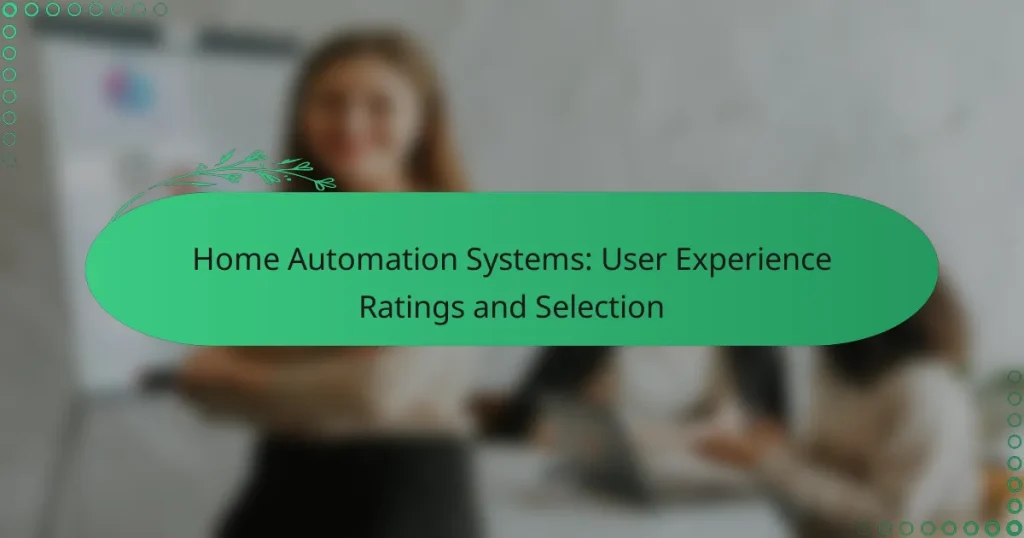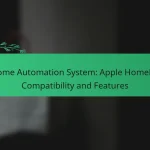Home automation systems have revolutionized the way we interact with our living spaces, emphasizing user experience through ease of use and seamless integration. Popular options like Google Nest Hub, Amazon Echo Plus, and Apple HomePod cater to diverse preferences, each offering unique functionalities. By examining user experience ratings, consumers can make informed decisions that align with their specific needs and existing devices.

What are the best home automation systems for user experience?
The best home automation systems for user experience prioritize ease of use, integration capabilities, and responsive performance. Systems like Google Nest Hub, Amazon Echo Plus, and Apple HomePod are among the top choices, each offering unique features that cater to different user preferences.
Google Nest Hub
The Google Nest Hub excels in providing a user-friendly interface with a touchscreen that simplifies control over smart home devices. It integrates seamlessly with Google Assistant, allowing voice commands for various functions, from adjusting lights to checking the weather.
Consider its compatibility with a wide range of smart home products, which enhances its versatility. Users appreciate the visual feedback on the display, making it easier to manage multiple devices at once. However, it may not support every brand, so check compatibility before purchasing.
Amazon Echo Plus
The Amazon Echo Plus stands out for its built-in Zigbee hub, which simplifies the connection of compatible smart devices without needing additional hubs. This feature makes it a great choice for those looking to streamline their home automation setup.
With Alexa as its voice assistant, users can control devices, play music, and access information hands-free. The Echo Plus also offers a robust ecosystem of compatible devices, but be mindful that some advanced features may require additional subscriptions or services.
Apple HomePod
The Apple HomePod is designed for users deeply integrated into the Apple ecosystem, offering excellent sound quality and Siri integration. It allows for voice control of smart home devices through Apple’s HomeKit, ensuring a secure and private experience.
While the HomePod provides a premium audio experience, its compatibility is more limited compared to other systems. Users should consider whether their existing devices support HomeKit before investing. Additionally, the HomePod’s higher price point may be a factor for budget-conscious consumers.

How do user experience ratings compare across systems?
User experience ratings for home automation systems vary significantly, reflecting differences in functionality, ease of use, and customer satisfaction. Evaluating these ratings can help consumers make informed choices based on their specific needs and preferences.
Consumer Reports ratings
Consumer Reports provides comprehensive ratings for various home automation systems, focusing on reliability, ease of installation, and user satisfaction. Systems often receive scores based on extensive testing and user feedback, with top-rated products typically scoring in the high 80s to low 90s out of 100.
When considering Consumer Reports ratings, look for systems that excel in areas relevant to your lifestyle, such as compatibility with existing devices and customer support. Pay attention to the detailed breakdown of features that contribute to overall scores, as this can guide your selection process.
TechRadar reviews
TechRadar offers in-depth reviews of home automation systems, analyzing performance, features, and user experience. Their ratings often highlight strengths and weaknesses, providing a nuanced view that goes beyond numerical scores. Products that receive high praise typically feature intuitive interfaces and robust integration capabilities.
In addition to ratings, TechRadar reviews include practical insights on installation and everyday use. Consider their recommendations for specific use cases, such as smart security or energy management, to find a system that aligns with your needs. Look for systems that are frequently updated, as this can enhance long-term usability and security.
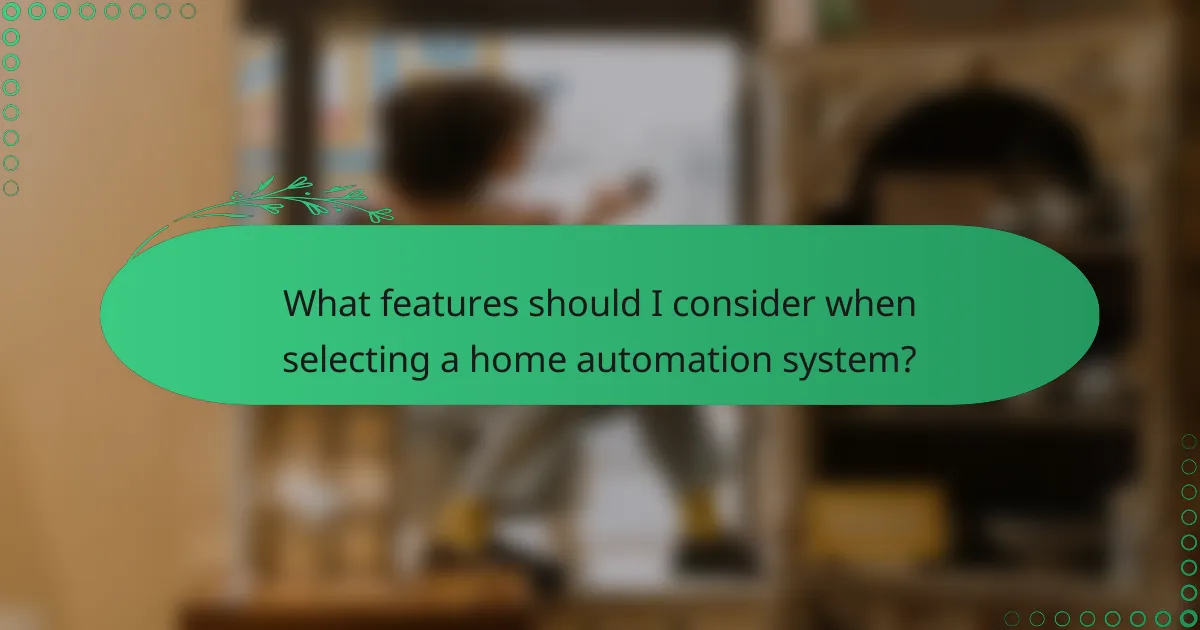
What features should I consider when selecting a home automation system?
When selecting a home automation system, consider compatibility with your existing devices, the design of the user interface, and voice control capabilities. These features significantly impact usability and the overall effectiveness of the system in managing your home environment.
Compatibility with devices
Compatibility is crucial when choosing a home automation system, as it determines how well the system integrates with your existing devices. Look for systems that support a wide range of devices, including smart lights, thermostats, security cameras, and appliances from various manufacturers.
Check for compatibility with popular standards such as Zigbee, Z-Wave, and Wi-Fi. A system that supports multiple protocols can provide greater flexibility and future-proofing as you expand your smart home setup.
User interface design
The user interface design of a home automation system should be intuitive and easy to navigate. A well-designed interface allows users to control devices effortlessly, whether through a mobile app, web portal, or physical control panel.
Consider systems that offer customizable dashboards and clear visual representations of your home. A good user interface should minimize the number of steps needed to perform tasks, making it accessible for all family members, including those who may not be tech-savvy.
Voice control capabilities
Voice control capabilities enhance the convenience of a home automation system, allowing users to manage devices hands-free. Look for systems that are compatible with popular voice assistants like Amazon Alexa, Google Assistant, or Apple Siri.
Evaluate the responsiveness and accuracy of voice commands, as well as the range of functions that can be controlled via voice. A system that supports multiple languages and dialects can be beneficial in multilingual households.

What are the pricing tiers for popular home automation systems?
Home automation systems typically fall into three pricing tiers: entry-level, mid-range, and premium. Each tier offers different features and capabilities, catering to various budgets and user needs.
Entry-level systems
Entry-level home automation systems generally range from around $50 to $200. These systems often include basic functionalities such as smart lighting, simple security cameras, and basic voice control.
When selecting an entry-level system, consider compatibility with existing devices and ease of installation. Popular options include smart plugs and basic hubs that can control a few devices through a single app.
Mid-range options
Mid-range home automation systems typically cost between $200 and $800. They offer more advanced features, such as enhanced security options, multi-room audio, and integration with various smart home devices.
These systems often come with user-friendly interfaces and can support a wider range of devices. Look for systems that allow for customization and scalability, enabling you to expand your setup as your needs grow.
Premium systems
Premium home automation systems usually start at around $800 and can exceed several thousand dollars. These systems provide comprehensive solutions, including whole-home automation, advanced security features, and professional installation services.
Investing in a premium system often means access to the latest technology and seamless integration with high-end appliances. Consider systems that offer robust customer support and warranty options to ensure long-term satisfaction.
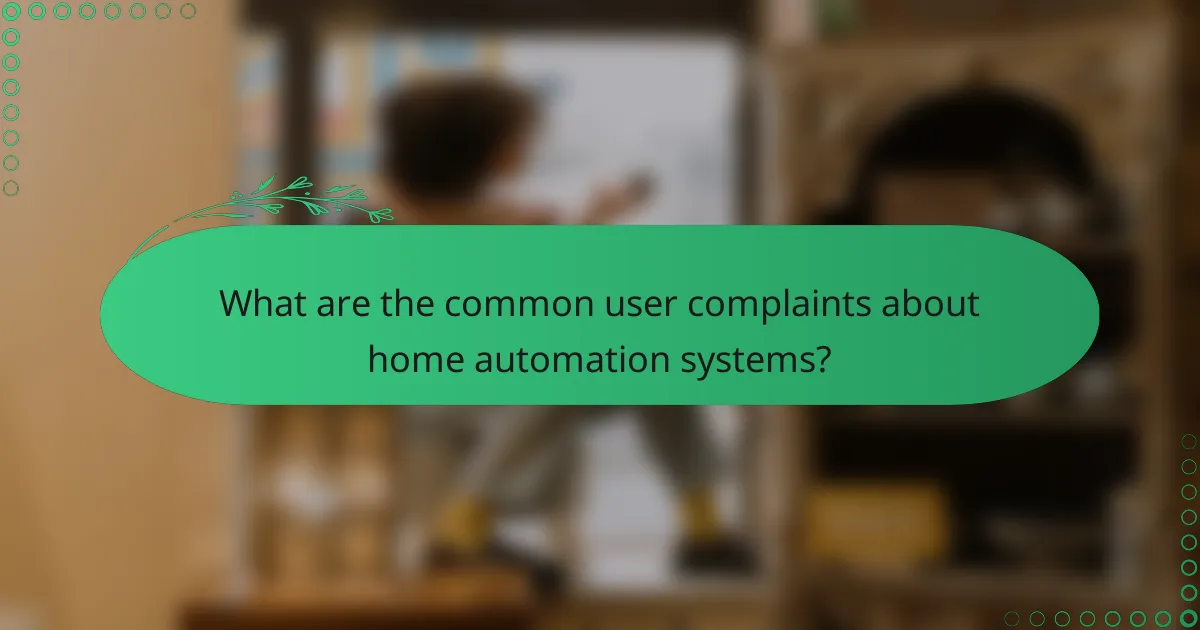
What are the common user complaints about home automation systems?
Users frequently report issues with home automation systems, primarily focusing on connectivity problems and complex setup processes. These complaints can significantly impact the overall user experience and satisfaction with the technology.
Connectivity issues
Connectivity issues are among the most common complaints regarding home automation systems. Users often experience dropped connections, slow response times, or devices that fail to communicate with each other. These problems can stem from poor Wi-Fi coverage, interference from other electronic devices, or incompatibility between different brands.
To mitigate connectivity issues, ensure that your router is centrally located and consider using Wi-Fi extenders or mesh networks to enhance coverage. Regularly updating device firmware can also improve performance and stability.
Complex setup processes
Many users find the setup processes for home automation systems to be overly complicated and time-consuming. This complexity can arise from the need to configure multiple devices, integrate various platforms, or navigate intricate software interfaces. As a result, some users may abandon the system altogether due to frustration.
To simplify the setup, choose systems that offer user-friendly interfaces and clear instructions. Look for devices that support easy integration with existing smart home ecosystems, which can streamline the installation process. Additionally, consider seeking assistance from customer support or online tutorials if you encounter difficulties during setup.
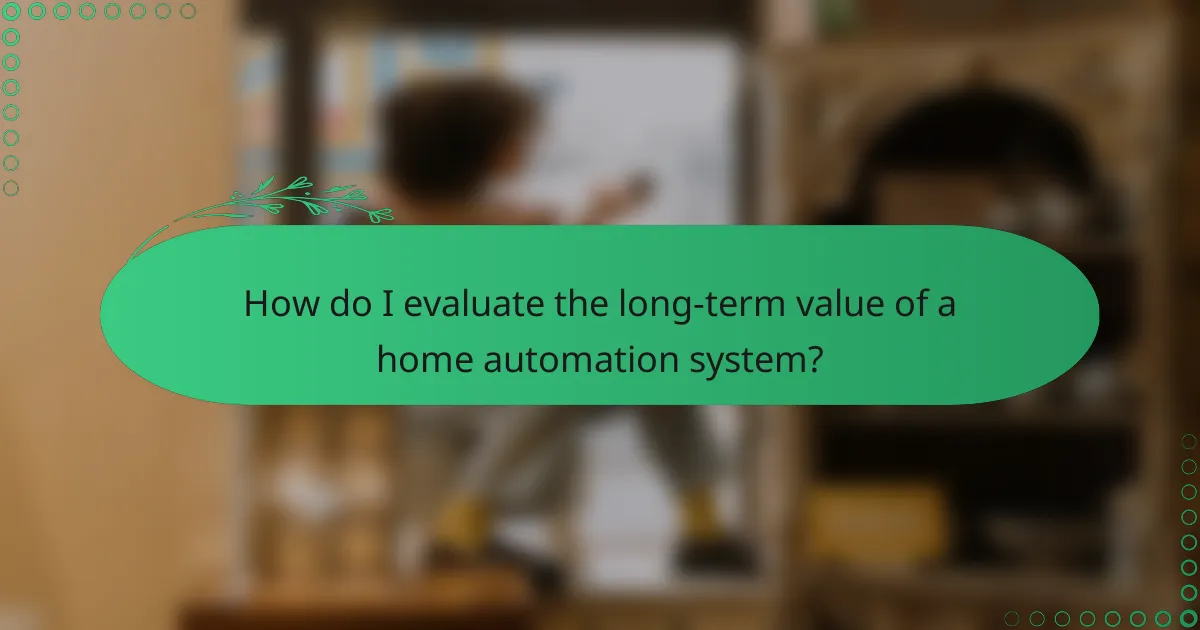
How do I evaluate the long-term value of a home automation system?
To evaluate the long-term value of a home automation system, consider factors such as initial costs, ongoing maintenance, and potential energy savings. Assess how well the system integrates with your lifestyle and its adaptability to future technology.
Initial Costs
Initial costs for home automation systems can vary widely, typically ranging from a few hundred to several thousand dollars. This includes the price of hardware, installation, and any necessary software. It’s essential to compare different systems and determine what features are essential for your needs.
Consider whether you want a DIY system or a professionally installed one, as this can significantly impact your budget. DIY systems may save money upfront but can require more time and effort to set up.
Ongoing Maintenance
Ongoing maintenance costs can include software updates, subscription fees for cloud services, and potential repairs. Many systems offer a subscription model for advanced features or support, which can add to your long-term expenses.
Evaluate the warranty and support options available with your chosen system. A robust support plan can mitigate future costs and ensure your system operates smoothly over time.
Energy Savings
Home automation systems can lead to energy savings by optimizing heating, cooling, and lighting based on your usage patterns. Many users report reductions in energy bills of around 10-30% after implementing smart technology.
Look for systems that provide energy monitoring features, as these can help you track savings and adjust usage accordingly. Consider the environmental impact as well, as energy-efficient systems contribute to sustainability efforts.
Integration and Compatibility
Ensure that the home automation system you choose is compatible with your existing devices and platforms. Systems that integrate well with smart speakers, security cameras, and other devices offer a more seamless experience.
Research the ecosystem of the system, as some brands have proprietary devices that may limit your options. A versatile system that supports various brands can enhance your home’s automation capabilities.
Future-Proofing
Consider the long-term viability of the home automation system by evaluating its adaptability to new technologies. Systems that offer regular updates and support for emerging technologies will provide better longevity.
Check if the manufacturer has a history of innovation and responsiveness to user feedback. This can indicate their commitment to improving the system and keeping it relevant in the evolving tech landscape.
